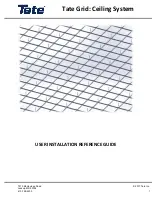
6. GENERAL MAINTENANCE AND ADJUSTMENTS
Page 127
© 2005 DH Instruments, Inc.
6.6.3.3
LUBRICATING THE PISTON-CYLINDER MODULE
The purpose of piston-cylinder module lubrication is to minimize wear to its
components. The proper long term functioning of the module requires that
specific areas of certain components be properly lubricated, especially after they
have been cleaned.
Lubricant
Vacuum Grease: DuPont Krytox GPL-205/6 is the recommended lubricant.
Krytox is selected because it is a non-reactive, nonflammable, oxygen service
safe grease. Very small amounts are used. Krytox is made of perfluoropolyether
(PFPE) thickened with polytetrafluoroethylene (PTFE). Users should avoid
contact with eyes and skin.
A tube of Krytox GPL-205/6 is included in the PG7601 Platform accessory kit.
Where to Lubricate
The lubrication chart in Figure 56 depicts the areas that require application of
vacuum grease. A thin film (i.e. just enough lubricant to fully cover the area
indicated) applied to these areas is all that is necessary. Lubrication with more
than a thin film will increase the cost of lubrication and may result in
contamination of the piston and/or cylinder. Areas not indicated for lubrication
should be kept free from vacuum grease.
Lubricating O-Rings
O-rings identified for lubrication should be lubricated prior to installation. During
service O-rings may be left in place and a thin film of vacuum grease applied to
the outside diameter. Vacuum grease may be applied by placing a drop (3-4mm
diameter - approximately 15-30mg) of grease between the thumb and forefinger
and then rolling the O-ring between the thumb and forefinger to apply a thin film
over the entire o-ring (use of gloves is recommended). An alternate method is to
place a drop (3-4mm diameter - approximately 15-30mg) of vacuum grease in a
small zip closure plastic bag (just large enough to fit the largest O-ring). Place
the O-ring in the bag, close the bag, and then gently work the vacuum grease
over the entire O-ring.
Spring Carrier Lubrication
The spring carrier is lubricated at
DHI
. Under normal conditions it is not
necessary for the user to remove the spring carrier for lubrication. In the event
that lubrication is necessary, use caution during disassembly. Remove the clip,
spacer, spring carrier and springs (qty 6). Lubricate the spring carrier as shown
in the lubrication chart. Reassemble, using care to install the springs, spacer
and clip in the reverse order of disassembly.
Pistons and Cylinders
Pistons and cylinders should be kept free from vacuum grease and any other
contaminant. Vacuum grease or other contaminants on the piston or cylinder will
adversely affect the piston-cylinder module’s performance.
Summary of Contents for ADCS-601
Page 10: ...ADCS 601 OPERATION AND MAINTENANCE MANUAL 2005 DH Instruments Inc Page VIII N NO OT TE ES S ...
Page 12: ...ADCS 601 OPERATION AND MAINTENANCE MANUAL 2005 DH Instruments Inc Page X N NO OT TE ES S ...
Page 19: ...2 SYSTEM OVERVIEW Page 7 2005 DH Instruments Inc Figure 2 ADCS 601 system pneumatic schematic ...
Page 114: ...ADCS 601 OPERATION AND MAINTENANCE MANUAL 2005 DH Instruments Inc Page 102 N NO OT TE ES S ...
Page 116: ...ADCS 601 OPERATION AND MAINTENANCE MANUAL 2005 DH Instruments Inc Page 104 N NO OT TE ES S ...
Page 146: ...ADCS 601 OPERATION AND MAINTENANCE MANUAL 2005 DH Instruments Inc Page 134 N NO OT TE ES S ...
Page 168: ...ADCS 601 OPERATION AND MAINTENANCE MANUAL 2005 DH Instruments Inc Page 156 N NO OT TE ES S ...
Page 174: ...ADCS 601 OPERATION AND MAINTENANCE MANUAL 2005 DH Instruments Inc Page 162 N NO OT TE ES S ...
















































